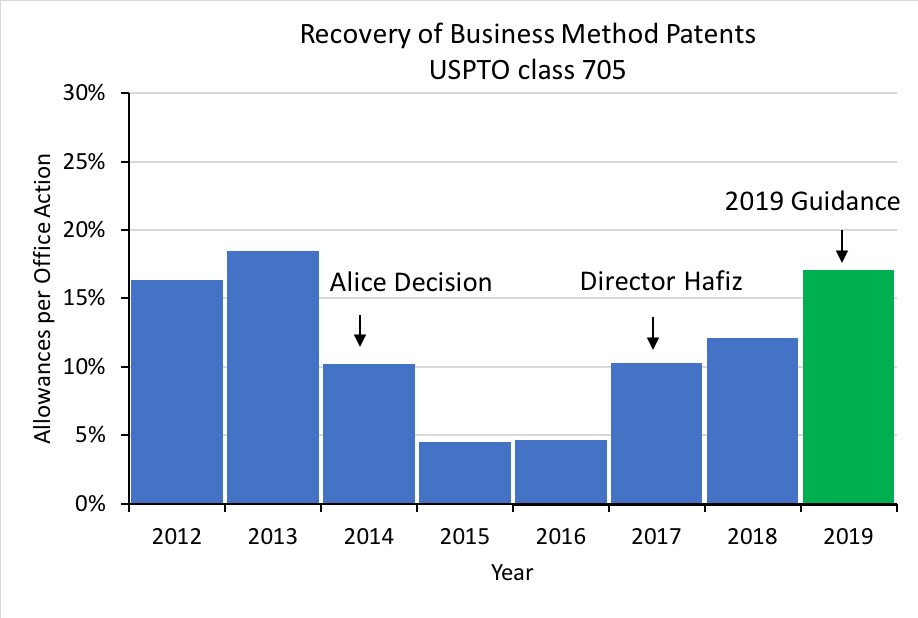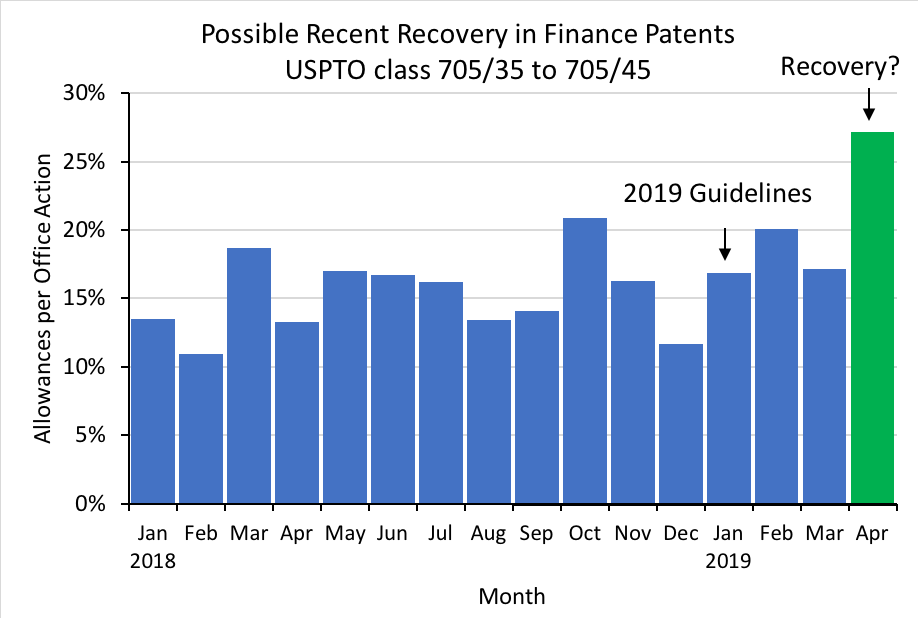“An APOA of 17% implies that, on average, an applicant will have to respond to five rejections before getting an allowance. Nonetheless, it is now at least a realistic possibility to get a business method patent in a reasonable amount of cost and time.”
Business method patents have recovered under the new 2019 Revised Patent Subject Matter Eligibility Guidance. As the graph above shows, allowances per office action (APOA) dropped from 17% before the 2014 Alice decision to 4% right after the Alice decision. APOA then increased to about 11% in 2017 when a new business method director, Tariq Hafiz was appointed. Tariq made a special point of encouraging examiners to allow cases if they genuinely felt the claims met the 101 guidelines set forth by the patent office. APOA rose to 17% in 2019 after the new 2019 Guidance came out in January. It is now back at its pre-Alice level of 17%.
 It’s still not easy to get a business method patent. An APOA of 17% implies that, on average, an applicant will have to respond to five rejections before getting an allowance. Nonetheless, it is now at least a realistic possibility to get a business method patent in a reasonable amount of cost and time.
It’s still not easy to get a business method patent. An APOA of 17% implies that, on average, an applicant will have to respond to five rejections before getting an allowance. Nonetheless, it is now at least a realistic possibility to get a business method patent in a reasonable amount of cost and time.
 Just last month, I was saying that it looked like finance patents had not recovered under the 2019 Guidance. See “AI patents Make a Comeback at USPTO, Finance Patents are Still Struggling”. Finance patents (USPTO class 705/35 to 705/45) are the largest subgroup of business method patents. The most recent month-by-month data, however, shows that there has been an uptick in the APOA for finance patents in April. Hopefully, this trend continues.
Just last month, I was saying that it looked like finance patents had not recovered under the 2019 Guidance. See “AI patents Make a Comeback at USPTO, Finance Patents are Still Struggling”. Finance patents (USPTO class 705/35 to 705/45) are the largest subgroup of business method patents. The most recent month-by-month data, however, shows that there has been an uptick in the APOA for finance patents in April. Hopefully, this trend continues.
Raise the Right Questions
Now that there is recovery in business methods, there are a number of issues inventors might want to raise with their patent attorneys/agents. These issues include:
- Is my examiner allowing cases? Just because the averages are up, doesn’t mean every examiner is up. There are more than 30 examiners in business methods that have yet to allow a case this year. It is essential, therefore, to check and see if your particular examiner is allowing. This will help guide your strategy.
- What is my examiner allowing? It is very helpful to see exactly what your examiner is allowing. This will show your attorney/agent how to amend your claims to look more like what the examiner is allowing.
- What about my appeal? If you have already filed an appeal, it might be worthwhile to interview the examiner and see if the new guidance creates new possibilities for amending your clams to get them in condition for allowance. If you can reach agreement with the examiner, then you can withdraw the appeal, amend your claims and request continued examination. If you can’t reach agreement with your examiner, then you can let your appeal proceed.
The 2019 Guidance has created new possibilities for getting business method patents allowed. The situation is still very dynamic, however, and it pays to keep track of how it evolves so that you can be in the best position to get your claims allowed.

![[IPWatchdog Logo]](https://ipwatchdog.com/wp-content/themes/IPWatchdog%20-%202023/assets/images/temp/logo-small@2x.png)

![[Advertisement]](https://ipwatchdog.com/wp-content/uploads/2024/04/Patent-Litigation-Masters-2024-sidebar-early-bird-ends-Apr-21-last-chance-700x500-1.jpg)

![[Advertisement]](https://ipwatchdog.com/wp-content/uploads/2021/12/WEBINAR-336-x-280-px.png)
![[Advertisement]](https://ipwatchdog.com/wp-content/uploads/2021/12/2021-Patent-Practice-on-Demand-recorded-Feb-2021-336-x-280.jpg)
![[Advertisement]](https://ipwatchdog.com/wp-content/uploads/2021/12/Ad-4-The-Invent-Patent-System™.png)







Join the Discussion
6 comments so far.
Anon
May 22, 2019 02:50 pmThanks Clint – I would add that the Finnavations case more than doubles down on Cleveland Clinic case.
Taken to its “logical” extreme, the re-writing of patent law per Finnavations is that examination is absolutely meaningless, that the presence and level of the presumption of validity is absolutely meaningless and that we actually have a mere registration system with a meaningless almost*** multi-Billion dollar innovator tax slapped on top of the registration system.
*** I say “almost” because there are other costs that would be incurred with an actual registration system — be it fractions of a cent on the dollar — that still would need be paid for.
Clint Mehall
May 22, 2019 01:16 pmAnon,
I agree that such a strategy cannot hurt depending on the circumstances. In the above-mentioned instance, there was plenty of argumentation on record in the Appeal Brief and Reply Brief, along with remarks in a Supplemental Response filed with the RCE withdrawing the case from appeal, as to why the claims are directed to statutory subject matter under existing case law (and/or different from claims ruled ineligible under existing case law). I believe that our chances of success were rather high in winning at the PTAB, regardless of whether the PTAB reviewed the claims under the January 101 Guidance or existing case law, but the RCE was filed as an expedient in an unpredictable landscape.
In any event, the courts do not seem to give the slightest deference to considerations during prosecution, as shown by the recent cases Finnavations, LLC v. Payoneer, Inc., 2018 U.S. Dist. LEXIS 199386 (invalidating claims under 101 on the merits) and Finnavations, LLC v. Payoneer, Inc., 2019 U.S. Dist. LEXIS 45306 (awarding reasonable attorney fees to the prevailing party), where there were four different 101 rejections during prosecution, the Notice of Allowance mentioned the claims were analogous to claims in Enfish, McRO and Bascom Global, but the district court went as far as to say that asserting the claims were directed to statutory subject matter at the district court was so unreasonable that attorney fees were awarded to the defendant.
But I would still agree that it likely cannot hurt, as I would definitely not expect an examiner to issue written remarks saying that the claims are only directed to statutory subject matter under the January 2019 101 Guidance. I imagine the USPTO Director would not be happy if such remarks were issued.
Anon
May 22, 2019 11:07 amClint,
I have to wonder if you attempted to inoculate your client from the post grant audiences to which a granted patent will be subject to.
As we have seen, the judicial branch is perfectly willing to state that just because a patent was granted (under ANY protocol – see at least the Cleveland Clinic case in which a continuation application had a claim directly modeled on a protocol example, yet court-ruled ineligible) does not mean that the patent won’t be thrown out.
Discussions in our office (as well as publicly discussed in a recent USPTO Customer Partnership meeting) have indicated having a strategy of pursuing the allowance by way of protocol, but also putting in the record that applicant holds that the claims are patent eligible under any protocol and under the strictest interpretations of the courts. It is not likely that an examiner would (could?) take issue with such a statement being made by an applicant, and the actual weight of such a statement has not yet been weighed in a court of law (naturally, at this point), so whether or not this attempt would bear fruit, but those in favor indicate that at least this tries to place the issue on the record, and opens the door for a factual confrontation in any later court forum.
Your thoughts…?
Clint Mehall
May 21, 2019 11:10 amAfter the January 101 Guidance was issued, I contacted an examiner in a case already forwarded to the PTAB for decision (i.e., after the Reply Brief was filed). The examiner spoke with me and indicated the new 101 Guidance rendered the 101 rejection – the sole rejection – moot. The Examiner agreed that if a RCE was filed the case would be allowed. Accordingly, I filed a RCE and a Notice of Allowance was issued. My main point – it never hurts to call an examiner and ask. Worse case scenario is you are in the same situation, best case scenario you have a very happy client.
Mark Nowotarski
May 20, 2019 01:42 pmMPEP-Citation,
You make a number of good points. Whether or not to contacting an examiner or the examiner’s SPE after submission of an appeal brief is a judgement call on the part of the attorney or agent. This is an unusual situation so a call might be worthwhile.
MPEP-Citation
May 20, 2019 01:06 amOn point 3, “what about my appeal”. Rule 41.35 seems to indicate the case would be under the jurisdiction of the board if on appeal. Accordingly, wouldn’t further prosecution/record with the examiner be potentially problematic and/or muddying the record. Also of note, MPEP 713.05 “Except in unusual situations, interviews with examiners are not permitted after the submission of an appeal brief or after a notice of allowability for the application has been mailed.”